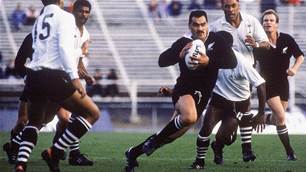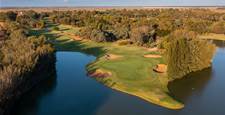It is more than just a little ironic that the oldest golf club on Victoria’s Mornington Peninsula, Flinders Golf Club, might also be the region’s most underrated.
The rich cluster of world class courses on the Mornington all lie to the west of Flinders, which sits above the ocean near West Head at the entrance to Western Port Bay. It is a dreamy location with views to the east to Phillip Island and south over the chilly looking waters of Bass Strait.
It is – geographically speaking – at the end of the line, which has helped the Flinders club maintain a lower profile than some of its neighbouring courses, the closest of which is the RACV Cape Schanck Resort nearly 20 minutes’ drive away.
But for those golfers willing to travel the extra mile to discover new wonders, Flinders doesn’t disappoint.
There is an old-world charm about this seaside gem, which is not surprising as golf has been played here for 120 years. At least that’s how long Flinders Golf Club has been in existence, but golf by the sea here dates back even further to the late 1800s.
Flinders was an isolated fishing village when, in 1869, a cable station – to link Tasmania to the mainland – was built no more than a short par-4 from where the Flinders clubhouse stands today. In the years that followed the English and Scottish immigrants who worked at the station carved out four holes along the clifftops near the edge of the current course.
These holes piqued the interest of David Maxwell – a Scot who learned the game on the ancient layout of Montrose and was the inaugural club champion at the Melbourne Golf Club (which would later become The Royal Melbourne Golf Club).
Maxwell would later take the lead in the founding of the club and the design of the links, which were officially opened for play in 1903.
The original course had only a few trees scattered throughout the 18 holes. The opening hole was almost where it is today, while the 2nd played along the edge of a cliff. It was the original 3rd and 4th holes that attracted golfers to make the journey to Flinders.

The 3rd, known as Niagara, was a par-3 of 130 yards played from the top of a cliff down to a green on the edge of the beach. Golfers then trekked down dozens of steps through heavy bracken ferns to reach the putting surface. The next, called Spion Kop, was a blind par-4 of just 100 yards played from the high-water mark on the beach straight up the cliff face to a small green.
When the esteemed course architect Dr Alister MacKenzie came to Australia in 1926 to design Royal Melbourne Golf Club’s new Sandringham course, he visited several nearby Sandbelt courses as well as making the trip to Flinders. He was impressed, later writing that it was “equalled by only one other natural course, which is in California.”
MacKenzie prepared a brief report for the club recommending the closure of Niagara and Spion Kop to speed up play and the converting of the then 6th hole, known as the Coffin, from a par-3 to a short par-4.
The club (eventually) took MacKenzie’s advice, replacing Niagara and Spion Kop in 1950 and converting the Coffin, which now plays as the 4th hole, into what is widely regarded as one of the best short par-4 holes in Australia.
When MacKenzie visited in 1926, the green of the then par-3 was located between the two ravines or ‘coffins’. MacKenzie’s plan was to build a new green just beyond the second ‘purgatory’ ravine, move the tee back and play the hole as a ‘two-shot hole’, bringing both ravines into play where mishit tee shots would find the first coffin, and mishit approach shots, or overhit drives, would plunge into the purgatory coffin.
Even today, despite the advances in golf equipment technology and players hitting greater distances, the 272-metre Coffin hole asks the same strategic questions of players as it did in years long gone.

Strategy, as well as width and playability, are the foundations of Flinders’ next evolutionary phase on a course where 15 of the 18 holes are positioned as they were originally in 1903. But the addition of bunkers and mounds, narrower mowing lines, reshaped greens and the planting of trees and shrubs have all changed the characteristics of these holes.
Course designer Michael Henderson – who has studied many of the great layouts created during the Golden Age of course design and has worked with Tom Doak and the Renaissance Golf design team – has been commissioned by the club to create and implement a masterplan for the future of the course.
“An example of a hole at Flinders with great strategy is the famous 4th, where the golfer can attempt to go for the green, lay up well out to the right or lay-up closer to the cliff top on the left side,” Henderson, of Holes In The Ground Design, has noted in his plan. “Along with the spectacular cliff top views, the hole’s exemplary strategy is one of the reasons why it is so revered.

“While there are other less, obvious examples of strategy around the course, there are opportunities to greatly improve the architecture of many of the holes and introduce more strategic playing options.
“One key ingredient necessary to achieve strategy is playing width. The right amount of width allows the golfer to decide between alternate routes; it allows them to play safely away from danger if they choose to. Therefore, increasing the width of holes, particularly in landing areas, is a key focus of this masterplan.
“Increasing the fairway width and opening up alternate avenues of play will improve playability and interest for golfers of all levels.”
Henderson’s masterplan is a long-term one with strategic changes coinciding with the remodelling of most greens and bunkers to bring a level of consistency to the style of design.
“The shaping, style, playability and strategic influence of the greens and their surrounds, are a major focus of this masterplan,” Henderson says. “There is potential to rework most greens, slightly, to better complement the strategy of each individual hole.
“Notwithstanding, the existing greens give the course much of its character and their small size helps defend its modest length. Importantly, enhancements will seek to build on the character of the existing greens.”

The 3rd and 16th greens have recently been reconstructed and work is due to start on the 17th green.
In his masterplan, Henderson says reducing the number of bunkers that have little impact on play will see the total number of sandy hazards cut from 70 to 56, while some trees will also be removed to enable the course to reach its full strategic potential.
The implementation of the masterplan at Flinders will undoubtedly improve on what is already a wonderful golfing experience that has the course ranked at No.57 in Australia’s Top-100 Public Access Courses and climbing, after it improved 15 spots on its 2021 position.
“In a golf saturated area like Victoria’s Mornington Peninsula, Flinders has escaped some of the hype that surrounds most of the courses on the western side of the peninsula. But Flinders deserves more acclaim simply because it’s a bloody great course,” says Golf Australia Top-100 judge James Walsh.
You won’t get any argument from me James.
FACT FILE
LOCATION: Bass St, Flinders, Victoria.
CONTACT: (03) 5989 0583.
WEBSITE: www.flindersgolfclub.com.au
DESIGNERS: David Myles Maxwell and others (1903); Vern Morcom (1950); Peter Thomson, Mike Wolveridge & Ross Perrett (2001); Michael Henderson (2022 and ongoing).
COURSE SUPERINTENDENT: Tom Hogan.
PLAYING SURFACES: Santa Ana and Wintergreen coach (fairways); bentgrass (greens).
PGA PROFESSIONAL: Josh Shaw.
GREEN FEES: $45 (18 holes, weekdays); $65 (weekends).
ACCOLADES: No.57 in Golf Australia magazine’s Top-100 Public Access Courses ranking for 2023.
Related Articles

International Spotlight: Omanu Golf Club

Celebrity Kiwi couple tee off in paradise












